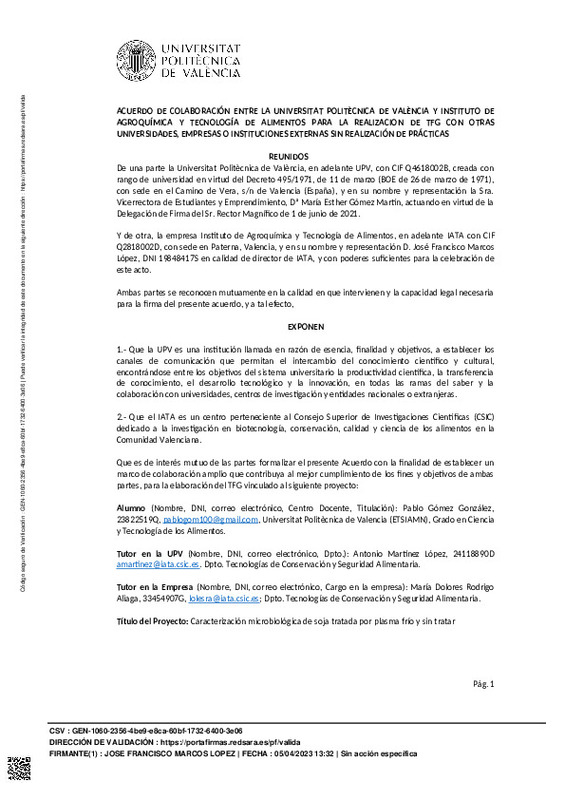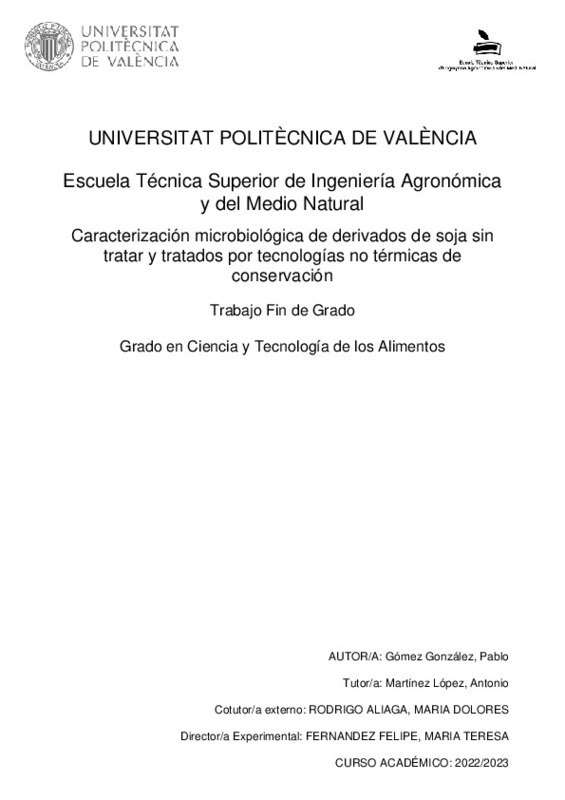|
Resumen:
|
[ES] En la actualidad, se están desarrollando nuevas tecnologías de higienización, que no utilizan el
calor y que permiten mejorar la seguridad y mantener las características organolépticas y
nutricionales de los ...[+]
[ES] En la actualidad, se están desarrollando nuevas tecnologías de higienización, que no utilizan el
calor y que permiten mejorar la seguridad y mantener las características organolépticas y
nutricionales de los alimentos. El plasma frío es una de estas nuevas tecnologías no térmicas, y
en este trabajo se determinará si es una técnica adecuada para higienizar la harina de soja, una
de las legumbres más utilizadas en la actualidad. En este estudio, se utilizan tres tipos de soja:
soja amarilla, soja negra y judía mungo, también conocida como soja verde.
Para el estudio de la eficacia de la higienización por plasma frío, se hizo una caracterización
microbiológica de las diferentes variedades de soja, antes y después de tratar. Para ello, se
realizaron ensayos de microbiología clásica para determinar la presencia de aerobios mesófilos,
mohos y levaduras, anaerobios esporulados sulfito-reductores, enterobacterias, estafilococos
coagulasa-positivos, Salmonella spp., Listeria spp., Escherichia coli y Bacillus cereus. Los
tratamientos de plasma se llevaron a cabo ionizando oxígeno y nitrógeno durante 10 y 20
minutos de exposición, a una potencia de 300W y los resultados se cotejaron en un ANOVA y
análisis post-hoc Tukey, observando que los distintos tratamientos con plasma frío sí disminuyen
significativamente la carga microbiana de la harina de las diferentes sojas. Esto significa que esta
tecnología sí contribuye a una mejora en la seguridad dado a la eficacia de las higienizaciones,
demostrando que podría resultar útil su implementación en la industria alimentaria.
[-]
[EN] Currently, new sanitizing technologies are being developed that do not use heat and that allow
improving the safety and maintaining the organoleptic and nutritional characteristics of foods.
Cold plasma is one of ...[+]
[EN] Currently, new sanitizing technologies are being developed that do not use heat and that allow
improving the safety and maintaining the organoleptic and nutritional characteristics of foods.
Cold plasma is one of these new non-thermal technologies, and this work will determine
whether it is a suitable technique for sanitizing soybean meal, one of the most widely used
legumes today. In this study, three types of soybeans are used: yellow soybean, black soybean
and mung bean, also known as green soybean.
To study the efficacy of cold plasma sanitization, a microbiological characterization of the
different soybean varieties was carried out before and after treatment. For this purpose,
classical microbiological tests were carried out to determine the presence of mesophilic
aerobes, molds and yeasts, sulfite-reducing sporulated anaerobes, enterobacteria, coagulasepositive staphylococci, Salmonella spp, Listeria spp, Escherichia coli and Bacillus cereus. The
plasma treatments were carried out by ionizing oxygen and nitrogen for 10 and 20 minutes of
exposure, at a power of 300W and the results were compared in an ANOVA and Tukey post-hoc
analysis, observing that the different cold plasma treatments do significantly decrease the
microbial load of the flour of the different soybeans. This means that this technology does
contribute to an improvement in safety due to the effectiveness of sanitizations, demonstrating
that its implementation in the food industry could be useful.
[-]
|








